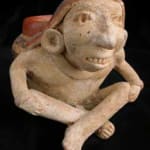Mayan Human Effigy Vessel, 6th Century CE - 9th Century CE
Terracotta
6.25 x 6.5
PF.3557
The Maya in their great temple cities reached the summit of the classical age in ancient Meso-America. In those temple cities, great artistic expressions such as murals and sculptures flourished....
The Maya in their great temple cities reached the summit of the classical age in ancient Meso-America. In those temple cities, great artistic expressions such as murals and sculptures flourished. It is during this classical period in which artists refined their skills to represent the human forms, deities and the symbolic art works. Used in various rituals and ceremonies, their art embodied rich symbolism, laden with complex meanings, which largely remain esoteric. This beautiful vessel depicts a sitting human figure with a jar-like vessel on his back. The remarkably sculpted face of the figure displays distinct Mayan physical characteristics such as the high cheekbones, fleshy and hooked nose, heavy lidded eyes, and fleshy lips. He denotes his status and wealth by wearing ear-flares, necklace, bracelets, and a painted headdress. Sitting with his legs crossed and with his hands on his knees, he undoubtedly expresses dignity and high status. The vessel is painted with warm earthy colors, adding to the sculpture's beauty and grace. Possibly depicting an image of a Mayan dignitary, this effigy vessel was most likely used in special rituals or ceremonies. Perhaps it was used in a funerary ritual in which it accompanied the deceased, containing significant potion in the vessel. Looking at this sculpture is like looking into the Mayan history in a pictorial view.



